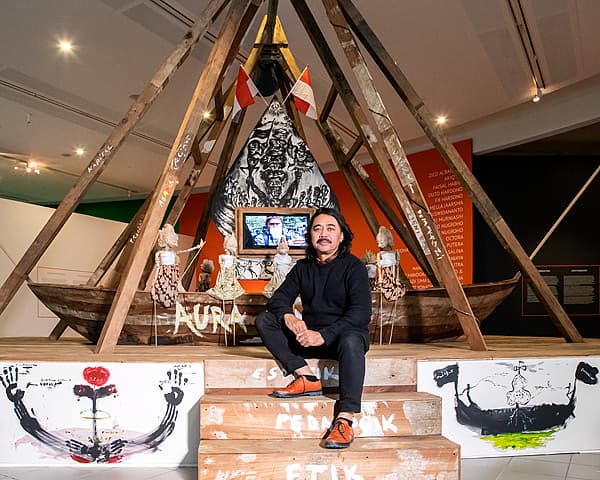Contemporary
worlds
Indonesia
Tisna Sanjaya
Senior Indonesian artist Tisna Sanjaya was a founding member of the 1980s Bandung-based art movement jeprut—a Sundanese word for a unique regenerative force. Jeprut is analogous to a short-circuiting of the everyday, where existing conditions are broken by an exploding light, resulting in new energies and possibilities. During Suharto’s reign, and together with his collaborators, Sanjaya staged performance-based ‘happenings’ of a tactically improvised and abstract nature. To shield the jeprut artists from government censure, works were performed and concluded quickly, existing only as ephemeral experience. Adopting the mantra ‘Say it (even if bitter), and then pray it’,1 Sanjaya’s works can be understood as art activism, publicly broadcast to local and global effect in the post-Reformasi era.
The artist’s performance installation Seni penjernih dialog (Art as purifying dialogue) 2019 borrows the form of an Indonesian boat known as the kora-kora, popularly recognised as a fairground ride of kinetic swinging action, and is a work experienced in two distinct parts.
The initial site-specific performance will incorporate a metal kora-kora sailed on the highly polluted Citarum River in Bandung,2 where Sanjaya will lead a series of public debates and discussions on a range of political and environmental issues between residents of the river, his local uleema (Islamic scholars), Indonesian military representatives, government officials and other professionals.
The open dialogue that results will be recorded and installed for his second performance at the National Gallery of Australia in Canberra. Here, Sanjaya’s work will take the form of a performance lecture, delivered by the artist on top of a wooden kora-kora, elaborately decorated with the artist’s visualisations of Pancasila and Khilafah—two competing religious ideologies. This double performance stretches Sanjaya’s work across two countries, with various participants and multiple audiences, forging a cross-cultural dialogue and a sociological striving for greater religious, cultural, social and transnational understanding: ‘my symbolic efforts, and art statement in response to the global and local era in a peaceful way’ is an ‘optimistic symbol of hope facing changes in the world’.
By welcoming Australian participants to join the discussions and to begin new ones in an open pedagogical program, the artist aims to ‘find a new way, a fresh and inspiring alternative peace effort. To work to find balance for humanity’s voice, a polite local ethic and spiritual value in the form of art’.
Jaklyn Babington
- All quotes in this entry are from Tisna Sanjaya in correspondence with the author, November 2018.
- The artist’s studio is near the Citarum River in Bandung. Much of the artist’s ongoing work engages with the environmental issues faced by the local river residents.

Tisna Sanjaya
